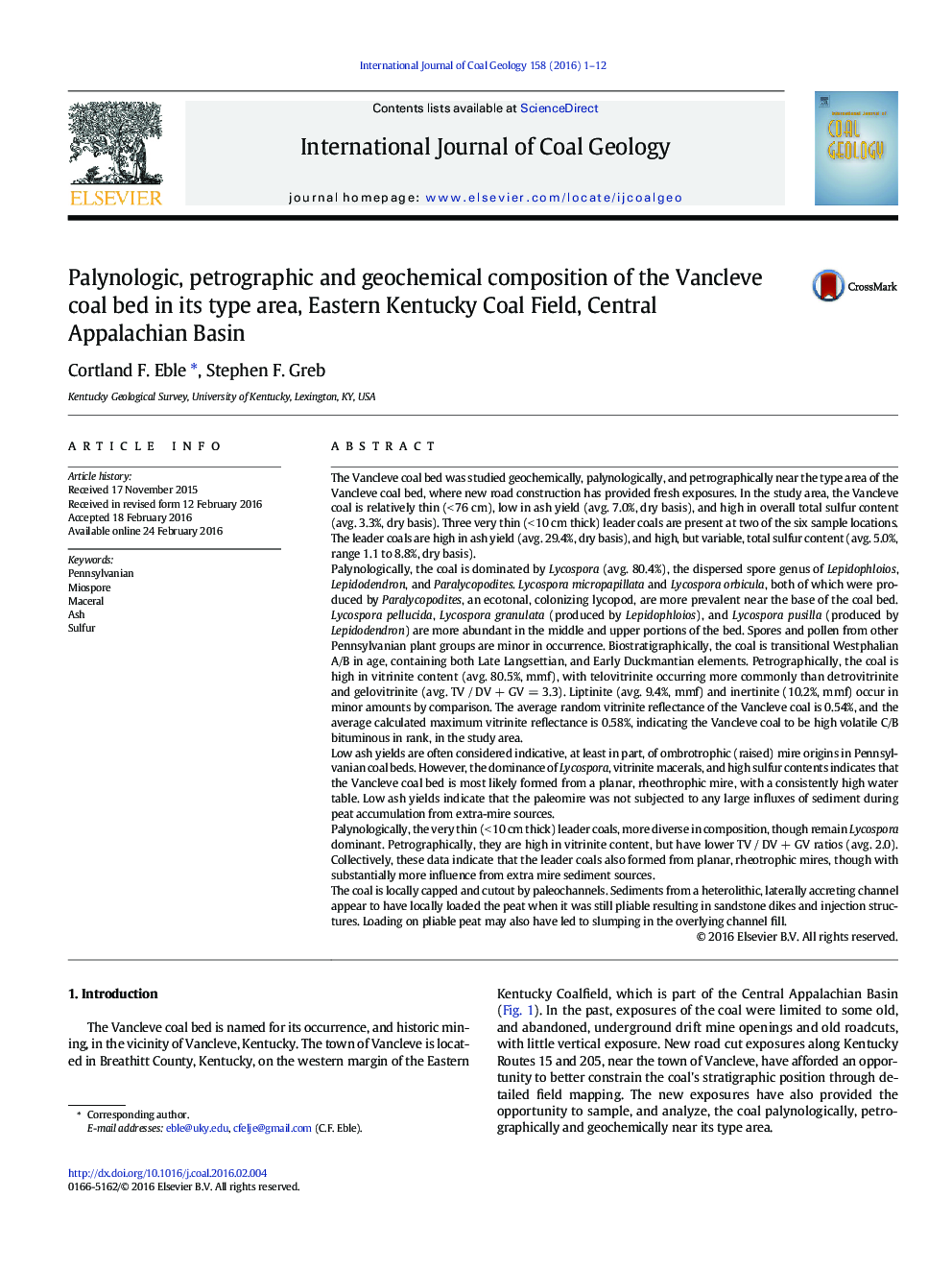| کد مقاله | کد نشریه | سال انتشار | مقاله انگلیسی | نسخه تمام متن |
|---|---|---|---|---|
| 1752789 | 1522544 | 2016 | 12 صفحه PDF | دانلود رایگان |
• The Vancleve coal bed was sampled near its type location.
• The coal is late Early Pennsylvanian in age.
• The coal is low in ash yield, and high in sulfur content.
• The coal is dominated by vitrinite macerals, and Lycospora miospores.
• The coal is interpreted to have formed from a rheotrophic, planar mire.
The Vancleve coal bed was studied geochemically, palynologically, and petrographically near the type area of the Vancleve coal bed, where new road construction has provided fresh exposures. In the study area, the Vancleve coal is relatively thin (< 76 cm), low in ash yield (avg. 7.0%, dry basis), and high in overall total sulfur content (avg. 3.3%, dry basis). Three very thin (< 10 cm thick) leader coals are present at two of the six sample locations. The leader coals are high in ash yield (avg. 29.4%, dry basis), and high, but variable, total sulfur content (avg. 5.0%, range 1.1 to 8.8%, dry basis).Palynologically, the coal is dominated by Lycospora (avg. 80.4%), the dispersed spore genus of Lepidophloios, Lepidodendron, and Paralycopodites. Lycospora micropapillata and Lycospora orbicula, both of which were produced by Paralycopodites, an ecotonal, colonizing lycopod, are more prevalent near the base of the coal bed. Lycospora pellucida, Lycospora granulata (produced by Lepidophloios), and Lycospora pusilla (produced by Lepidodendron) are more abundant in the middle and upper portions of the bed. Spores and pollen from other Pennsylvanian plant groups are minor in occurrence. Biostratigraphically, the coal is transitional Westphalian A/B in age, containing both Late Langsettian, and Early Duckmantian elements. Petrographically, the coal is high in vitrinite content (avg. 80.5%, mmf), with telovitrinite occurring more commonly than detrovitrinite and gelovitrinite (avg. TV / DV + GV = 3.3). Liptinite (avg. 9.4%, mmf) and inertinite (10.2%, mmf) occur in minor amounts by comparison. The average random vitrinite reflectance of the Vancleve coal is 0.54%, and the average calculated maximum vitrinite reflectance is 0.58%, indicating the Vancleve coal to be high volatile C/B bituminous in rank, in the study area.Low ash yields are often considered indicative, at least in part, of ombrotrophic (raised) mire origins in Pennsylvanian coal beds. However, the dominance of Lycospora, vitrinite macerals, and high sulfur contents indicates that the Vancleve coal bed is most likely formed from a planar, rheothrophic mire, with a consistently high water table. Low ash yields indicate that the paleomire was not subjected to any large influxes of sediment during peat accumulation from extra-mire sources.Palynologically, the very thin (< 10 cm thick) leader coals, more diverse in composition, though remain Lycospora dominant. Petrographically, they are high in vitrinite content, but have lower TV / DV + GV ratios (avg. 2.0). Collectively, these data indicate that the leader coals also formed from planar, rheotrophic mires, though with substantially more influence from extra mire sediment sources.The coal is locally capped and cutout by paleochannels. Sediments from a heterolithic, laterally accreting channel appear to have locally loaded the peat when it was still pliable resulting in sandstone dikes and injection structures. Loading on pliable peat may also have led to slumping in the overlying channel fill.
Journal: International Journal of Coal Geology - Volume 158, 15 March 2016, Pages 1–12
